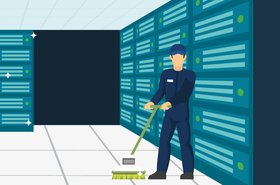It’s early May and the sun is finally starting to appear through the clouds - Spring is definitely in the air. With Spring comes the motivation to clean and freshen up. It’s a tradition to de-clutter your home at this time of year, but why not take it one step further and apply it to your data centers?
Spring cleaning your data centers, and the data that is stored within them, can be a good chance for organizations to be able to utilize data to its full potential – something that is ever important in this modern, data-hungry age. With this in mind, five IT experts share their tips and advice with DCD as to how to get motivated to achieve the dream clean data centers we all strive for.
Don’t forget the basics
When it comes to data centers, a regular schedule of equipment cleaning activities is essential to maintaining the maximum levels of uptime, as Timothy Arnold, head of colo at Six Degrees, acknowledges. This is something that is commonly understood by all data center managers. However, as Arnold goes on to advise, “what can sometimes be neglected is the cleaning of equipment that sits outside the data hall.
“The summer heatwave of 2018 put data center cooling systems throughout the UK to the test,” Arnold continued, “and I’m sure that there are data center managers out there who suffered some sleepless nights as equipment strained to deal with weeks on end of high temperatures.
“For me, last summer highlighted the importance of taking care of cooling plant equipment located on the data center roof. Unlike data hall equipment like servers and UPSs, all of which is located in a closely atmosphere-controlled environment, rooftop dry coolers are subject to the full force of the elements.”
To tackle this, Arnold suggests that, “with dust and particulants gathering around rooftop dry coolers year-round, it’s important to carry out spring cleaning activities on this outdoor equipment to ensure that each unit is in the best possible position to maximize uptime and maintain efficiency over the summer months.”
Additionally, as Steve Blow, tech evangelist at Zerto points out, “IT budgets are continually growing - and with more money naturally comes more spending.” However, because of this, as Blow goes on to say, “teams can end up with a different product or solution for every problem it faces, which can cause complete management chaos.”
It’s important for data centers to make sure they are not falling behind when it comes to new technologies, but as Blow advises, it’s also important to make sure that IT equipment isn’t just bought for the sake of it. Looking for “a platform that combines capabilities to solve multiple problems can be more efficient, cheaper, and easier to manage compared to scattered solutions that are hard to integrate,” he says.
This is something that Alan Conboy, office of the CTO at Scale Computing, agrees with. “One of the fastest growing developments today is edge computing,” he believes, “which takes compute and storage capabilities to the edge of our networks to capture and process data in real-time. With qualities like reliability, ease-of-use, high performance, self-healing, and affordability, edge computing is perfect for the distributed enterprise.
“This spring I challenge distributed enterprises across all verticals - retail, industrial, finance, and remote and branch offices - to evaluate their IT environment and see how they can deploy the latest technologies without needing a big budget or even an IT team to manage it.”
As Blow concludes, “sometimes, less is more, and this spring why not take some time to apply this theory to your IT?”
Keeping on top of things
It’s not just the data centers themselves that need to be continually looked after. These days, data is the lifeblood of a business, and so making sure that the data is regularly ‘cleaned’ and regulated is also a necessity.
Ángela Castillo-Gill, data scientist at Mango Solutions believes that, “like gold, data is constantly produced and flowing ‘downstream’.” With this in mind, Ángela goes on to say: “Gold is only valuable when it’s collected, cleaned, and consolidated. In the past, gold miners stood in a river with a pan, reliant on their expertise to judge if they’d collected something valuable to clean and sell for consolidation. This artisanal process seldom reached its full potential and is in sharp contrast to today’s structured mining that has clearly defined and documented processes which produce a commercially viable pipeline.
“Organizations are constantly producing data particles but often without any structured processes in place to collect, clean and consolidate - rather like the gold mining process of the ‘old days.’ Reliant on a few employees and their hard-earned expertise to judge that the data is useful, many of these companies unfortunately believe that their data is cleaner and more orderly than it actually is, inadvertently letting their gold flow away.
“Don’t let your company lose its gold,” Castillo-Gill concludes. “The sooner structured data checks and cleans are implemented from the point of data creation downstream, the more value you’re creating for your organisation in the long term. This value compounds when it’s consolidated over time, so the long-term rewards are even greater.”
Rod Harrison, CTO of StorCentric, Drobo's parent company, also adds: “Businesses and individuals alike should make the effort at this time of year to give their storage a ‘spring clean’ to clear out the old and make way for the new. It’s also the perfect time to re-evaluate the storage solutions you are using and consider whether there is a more cost-effective alternative. For individuals using multiple external drives, for example, a RAID (Redundant Array of Independent Disks) technology will ensure that if one drive fails, all is not lost. Making these conscious decisions now will help keep your data storage safe not just for Spring, but for every season.”
So, now that Spring has well and truly sprung, why not devote some time to your data centers and the data that’s stored in them? As the saying goes, ‘a clean home is a happy home,’ and the same can be said when applied to your IT.





